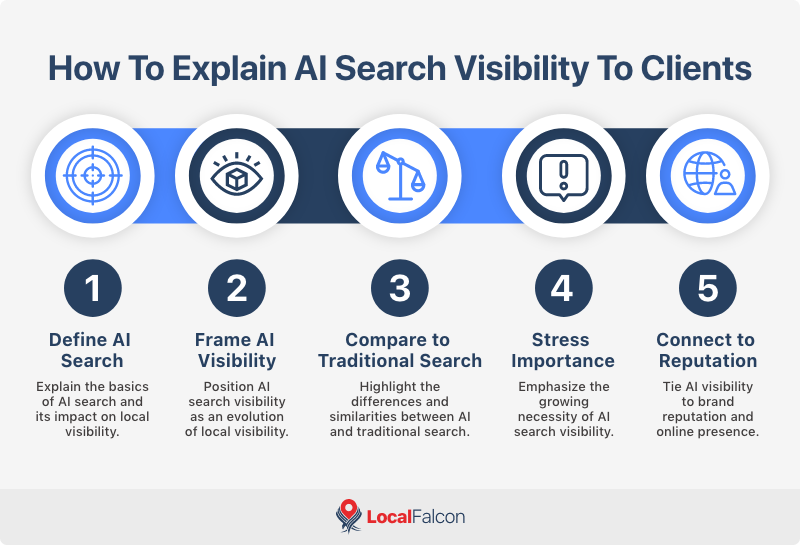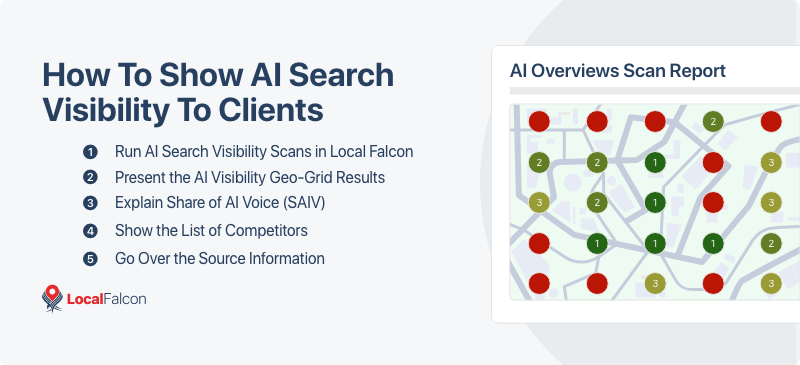Agencies face the difficult challenge of explaining and demonstrating the value of local SEO to clients who are usually more concerned with the actual running of their businesses. Fortunately, over the years most brick-and-mortar and service-area business owners have come to understand that local SEO is indispensable when it comes to driving business through local search, especially through Google Business Profile optimization and visibility.
But now there's a new, increasingly important layer of local search visibility that agencies need to explain to prospects and clients: AI search visibility. Comprehensive local visibility now means a business not only needs to be easy to find on Google Search, Maps, and other traditional local search engines and platforms, but also must be mentioned in AI-driven conversations.
Explaining (and showing) AI search visibility to business owners who are focused on their operations is both a new challenge and an exciting opportunity for local SEO agencies to differentiate themselves from competitors and provide added value to increase client buy-in and retention.

How To Explain AI Search Visibility To Clients
1. Start by Defining AI Search
Begin with the basics. Many business owners may not be familiar with AI search tools and how they affect local visibility. Some may even use AI tools without realizing that they are relevant to local SEO as well.
Explain that AI search refers to the new wave of search experiences powered by large language models (LLMs), tools that can understand context, search intent, and conversational phrasing, rather than just match keywords.
Give clients real examples: Google's AI Overviews and AI Mode, Gemini, ChatGPT, Claude, and Grok are all examples of platforms where users now ask for recommendations instead of performing traditional searches.
Clarify that these AI systems are trained to generate answers, not just show links. That means businesses aren't just competing for a spot in Google's 3-Pack or list of blue links anymore; they're competing for mentions within AI-generated responses.
2. Frame AI Search Visibility as How Discoverable Your Brand Is
Once clients understand what AI search is, frame AI search visibility as an evolution of local visibility.
AI search visibility describes how often and how prominently a business is mentioned across AI search platforms, whether that's inside Google's AI Overviews or in AI assistants like ChatGPT or Gemini when users ask for local recommendations.
AI tools increasingly provide direct suggestions for local businesses, sometimes complete with maps, ranked lists, and even summary blurbs. Being one of the businesses that these AI tools mention or recommend is now part of being fully discoverable in local search.
Agencies can explain this as the next frontier of "being found," the same concept clients already understand about Google and other traditional local search platforms, but expanded to everywhere consumers are now looking and asking questions.
3. Compare AI Search Visibility To Google Search and Maps Visibility
Stress that AI search isn't replacing traditional search, it's layering on top of it. Google Search and Maps are still the most important drivers of local traffic. However, even Google's search experience is rapidly becoming AI driven.
AI Overviews (AIOs) are now occupying top positions in the SERPs for local searches, summarizing results and sometimes listing a handful of businesses directly inside the AI-generated answer. Meanwhile, Google AI Mode and Gemini users are increasingly performing conversational searches to find local services, and that's just within Google.
Beyond Google, AI assistants like ChatGPT are being used to find local businesses meeting highly specific criteria. If a business isn't being surfaced in these results, it's missing out on a growing channel of discovery.
4. Stress the Growing Importance of AI Search Visibility
Consumers' search behavior is shifting. Many are now bypassing traditional results and making purchase decisions based solely on AI-generated recommendations.
This has resulted in the rise of zero-click local searches, searches in which a "click," traditionally one of the most important SEO metrics, never happens at all. A user could ask ChatGPT for the best local electrician, see a list of three recommendations, and immediately call the top one without ever visiting their business listing or website.
Agencies should stress how this means AI search visibility isn't optional, but rather a competitive necessity. Businesses that aren't optimizing for generative engines or tracking their presence across AI platforms are effectively invisible to a growing segment of potential customers.
Position this as both a risk (falling behind competitors) and an opportunity (getting ahead early in an emerging search layer).
5. Help Clients See AI Search as an Extension of Reputation and Branding
The best way to round out your explanation is to tie AI visibility to something every business owner understands: brand reputation.
Explain that AI tools are drawing from a wide range of online sources (not just Google) to decide which businesses to recommend. That includes mentions on review platforms, third-party directories, social media, and even in local news or blog articles.
So, improving AI search visibility is also about growing and curating the online footprint and reputation that LLMs see when they crawl and synthesize content. For clients, this connects AI visibility back to tangible efforts like review management, consistent listings, and content creation; areas they (hopefully) already understand as crucial parts of local SEO.

How To Show AI Search Visibility To Clients
1. Run AI Search Visibility Scans in Local Falcon
Start with data. Run AI search visibility scans in Local Falcon for all major platforms currently tracked, including AI Overviews, AI Mode, Gemini, Grok, and ChatGPT.
This establishes a baseline for how frequently your client's brand is appearing (or not appearing) in AI-generated responses and recommendations.
2. Present the AI Visibility Geo-Grid Results
The AI visibility geo-grid is a simple but powerful visual for clients. Each green dot represents a point where their business was mentioned in an AI-generated result, while red dots indicate areas where only competitors were mentioned instead.
This helps clients instantly visualize the geographic coverage of their AI visibility and see how much opportunity exists for improvement.
3. Explain Share of AI Voice
Next, introduce Share of AI Voice (SAIV), Local Falcon's metric for quantifying AI search visibility.
A higher SAIV means the business is a bigger "part of the conversation" across AI search experiences. Agencies can show progress by comparing SAIV growth over time, just as they do with Share of Local Voice (SoLV) for Google Business Profile visibility.
Along with the geo-grid visuals, this metric is key to demonstrating ROI from AI optimization efforts, making the abstract concept of "AI visibility" concrete and measurable.

4. Show the List of Competitors
Displaying the top competitors with the highest SAIV is an effective motivator. When clients can see which nearby businesses are dominating AI-generated mentions, it creates a sense of urgency and provides context.
You can frame this as: "These are the businesses that AI is recommending most often in your area. Increasing your Share of AI Voice will help you get mentioned alongside them in more of those recommendations."
5. Go Over the Source Information
Finally, demonstrate how AI tools reference a wide range of sources, from business listings to social media, reviews, and content from third-party sites. Local Falcon's AI search visibility reports provide a list of all the sources found in the scan, along with how many data points each source was used at.
This reinforces that AI search visibility is a multi-channel effort, and optimizing beyond Google can directly influence how often the brand appears in AI-generated answers. It also helps highlight areas where the agency can provide additional services or improvements to increase the client's SAIV.
Final Thoughts
AI search is rapidly reshaping how consumers discover local businesses. For agencies, being able to explain and, more importantly, show AI search visibility gives you a distinct competitive edge.
Combining education with data-driven visuals and metrics like SAIV, agencies can help clients understand this new layer of local visibility and see exactly how their brand is performing in the growing AI-powered search ecosystem.
The agencies that start tracking and optimizing AI visibility today will be the ones clients credit tomorrow for keeping them ahead of the curve.
FAQs About Explaining AI Search Visibility to Agency Clients
How can agencies measure AI search visibility?
Tools like Local Falcon now allow agencies to track AI search visibility through geo-grids and metrics like Share of AI Voice (SAIV), showing where a business is mentioned in AI-generated results and how it compares to competitors.
How should agencies position AI search visibility in client conversations?
Frame AI search visibility as the next evolution of local SEO, not a replacement for it. Clients already understand the importance of Google visibility, so explain AI visibility as an additional layer that ensures their business is also part of the conversations happening in AI assistants and generative search results.
What metrics resonate most with clients when discussing AI visibility?
Clients respond best to visuals and competitive comparisons. Use the Local Falcon geo-grid results to show where they appear (green) versus where competitors dominate (red), and focus on improving Share of AI Voice (SAIV) as a tangible measure of progress and ROI.
How can agencies integrate AI search visibility tracking into existing SEO reporting?
Blend AI visibility metrics with traditional local SEO metrics to create a unified visibility report. For example, include SAIV alongside Share of Local Voice (SoLV), Google Business Profile performance metrics, and Google Maps ranking data. This helps clients see how AI optimization complements their ongoing local SEO investment.
How can agencies use AI visibility data to upsell or retain clients?
AI visibility data naturally opens the door for new service offerings, such as generative engine optimization (GEO) and brand mention optimization. Regularly showing clients improvements in AI visibility helps reinforce your agency's value and demonstrate forward-thinking expertise.
What's the best way to keep clients engaged as AI search evolves?
Make education an ongoing part of your reporting. Share insights about how AI search tools are changing, highlight new features like Google's AI Overviews for local search results or ChatGPT's local recommendations, and show clients that your agency is staying ahead of emerging search behaviors rather than reacting to them after the fact.


